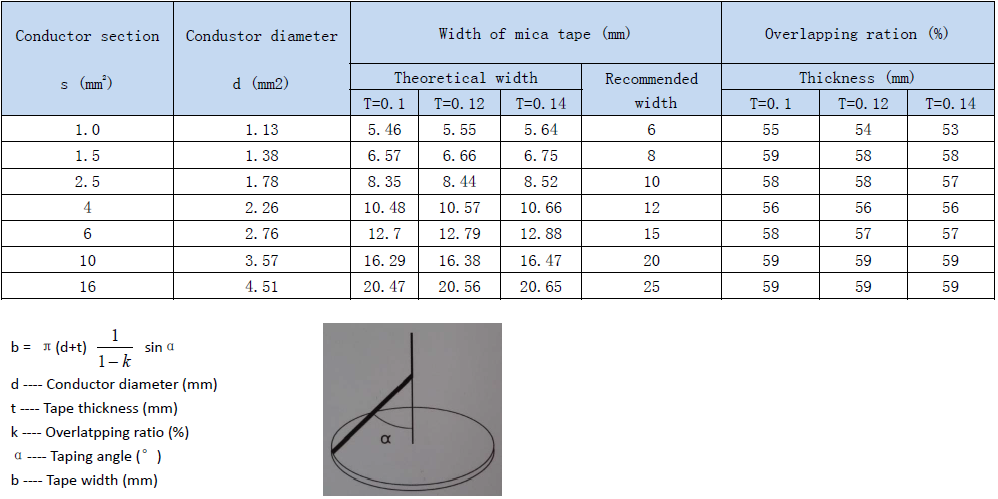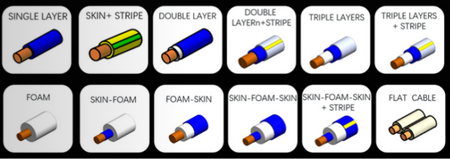FQA
Question?
This part need can add the question that customer ask most. This part need can add the question that customer ask most. This part need can add the question that customer ask most.
Is there any operation training ?
We offer staff training on your premises to individuals and groups, at a time to suit you, helping you make the most of your company’s human resources.
For fire‐resistant wire & cable, how to select suitable tape width?
Calculation based on recommended taping angle 45°and overlapping 50%. More tape width calculation formula as below:

Smaller taping angle increases the taping efficiency but at expense of conductor wrapping tightness which affects negatively for insulation property and extrusion.
Recommended taping angle for lowest friction on tape is 45°(+/-5°).
What is RoHS Compliance?
What is RoHS?
RoHS stands for Restriction of Hazardous Substances. RoHS, also known as Directive 2002/95/EC, originated in the European Union and restricts the use of specific hazardous materials found in electrical and electronic products. All applicable products in the EU market after July 1, 2006 must pass RoHS compliance.
What are the restricted materials mandated under RoHS?
The substances banned under RoHS are lead (Pb), mercury (Hg), cadmium (Cd), hexavalent chromium (CrVI), polybrominated biphenyls (PBB), polybrominated diphenyl ethers (PBDE), and four different phthalates (DEHP, BBP, BBP, DIBP).
Why is RoHS compliance important?
The restricted materials are hazardous to the environment and pollute landfills, and are dangerous in terms of occupational exposure during manufacturing and recycling.
How are products tested for RoHS compliance?
Portable RoHS analyzers, also known as X-ray fluorescence or XRF metal analyzers, are used for screening and verification of RoHS compliance.
Which companies are affected by the RoHS Directive?
Any business that sells applicable electronic products, sub-assemblies or components directly to EU countries, or sells to resellers, distributors or integrators that in turn sell products to EU countries, is impacted if they utilize any of the restricted materials.
What is RoHS 2 and how does differ from the original RoHS?
RoHS 2, or the Recast RoHS 2 Directive 2011/65/EU, was published in July 2011 by the European Commission. The scope of the original RoHS was expanded to cover all electrical/electronic equipment, cables, and spare parts with compliance required by July 22, 2019 or sooner depending on product category.
RoHS 2 is also a CE-marking directive, with RoHS compliance now being required for CE marking of products. As such, all manufacturers of electrical/electronic products must comply with RoHS 2 before the CE mark can be applied on their products. The original green RoHS label with the checkmark is no longer required or used as the CE mark now includes RoHS compliance.
RoHS 1 required that any product in scope should not contain any of the 6 restricted substances and that the company (manufacturer, importer, or distributor) placing the product on the EU market should maintain records to show compliance. RoHS 2 requires additional compliance recordkeeping from everyone in the supply chain. Additional compliance recordkeeping (which must be kept for 10 years) can include a conformity assessment, CE marking, maintenance of compliance throughout production, and self reporting of non-compliance. The proposed changes to the original RoHS Directive in RoHS2 (2011/65/EU) are minor. No additional substances have been added to the six currently restricted. Inclusion of RoHS categories 8 (medical devices) and 9 (control and monitoring instruments) products in RoHS has been added as well. RoHS 2 became law in July 2011 and took effect January 2, 2013.
What is RoHS 3 and how does it differ from RoHS and RoHS 2?
RoHS 3, or Directive 2015/863 was published in 2015 by the EU, and adds four additional restricted substances (phthalates) to the orginal list of six, as cited under REACH legislation.
What is RoHS 5/6?
RoHS 5 refers to compliance for 5 out of the 6 restricted substances (no compliance for lead (Pb)), while RoHS refers to compliance for all 6 substances.
What is REACH and how is it related to RoHS?
REACH is a general regulation and stands for Registration, Evaluation, Authorization, Restriction of Chemicals, and addresses the production and use of chemical substances and their potential impact on human health and the environment. REACH is monitored by the ECHA and deals with 38 chemicals currently. While RoHS bans substances present in electrical/electronic equipment, REACH controls all chemicals that might be used to make a product, including solvents, paints, and chemicals.
Ref: www.rohsguide.com


